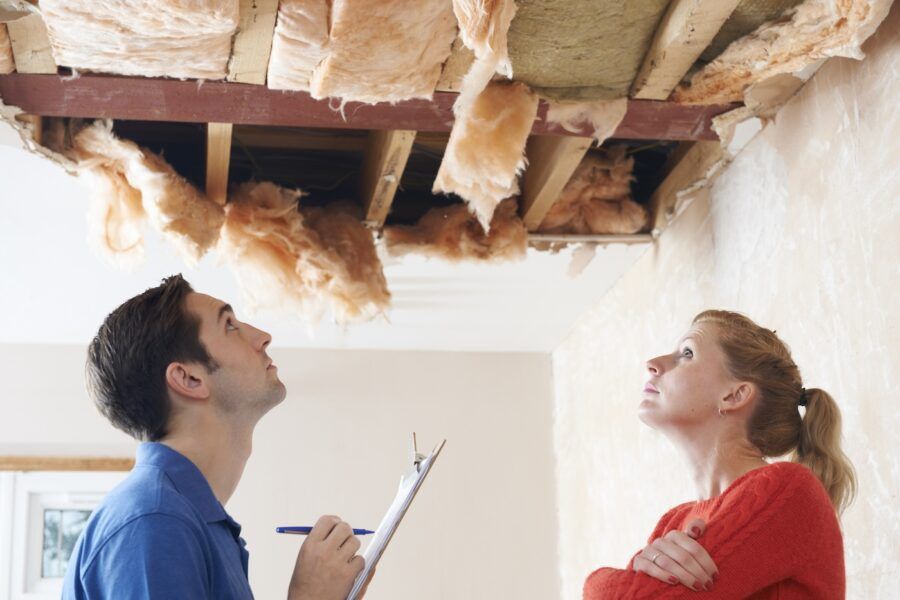In this article:
Home insurance claim adjusters investigate your homeowners insurance claim by assessing damage and determining coverage. They also might help guide policyholders through the claims process. Here's what you need to know about home insurance claim adjusters and the claim process.
What Are a Home Insurance Claim Adjuster's Responsibilities?
It's important to know that there's more than one type of adjuster:
- Your insurer typically assigns an in-house claim adjuster, or an independent claim adjuster, to your case after you file a home insurance claim. Among other things, they'll inspect the damage to your home and come up with an estimate for fixing the damage. These adjusters work on behalf of your insurance company, not on your behalf. As a result, you don't pay for their services.
- You can also hire a public adjuster to work on your behalf, and not on behalf of your insurance company, after you file a home insurance claim. This adjuster will negotiate with your insurer to settle your claim. An independent adjuster might charge you a flat rate or hourly rate, or might take a percentage of your claim payout.
Some, but not all, states mandate that insurance adjusters be licensed. If licensing is mandated, the adjuster must pass a state-required exam.
Among the things that an adjuster generally does when they visit your home are:
- Explain the claim process.
- Inquire about and review interior and exterior damage to your home. During the adjuster's tour, they'll normally take notes about and photos of all the damage, including damage done to fences, grills, patio furniture and similar items.
- Ask whether you've hired a contractor to fix the damage and, if so, what repairs they've recommended.
In some cases, an adjuster may be able to use remote technology to virtually inspect your home. But most of the time, they'll conduct an on-site inspection.
How Does the Claim Adjustment Process Work?
An adjuster likely will visit your home when you're there or even when you're not there. But it's best to be home when the adjuster arrives so you can answer questions and watch them work. As an alternative, an adjuster might rely on technology to remotely inspect your home. An on-site visit might last one to two hours.
If the insurance adjuster works on behalf of your home insurance company, they might:
- Spend roughly 45 to 60 minutes writing a report about their findings if they do it onsite.
- Tell you the claim appears to be valid or might tell you the claim is not valid.
- Explain how your claim will be paid. For instance, the adjuster may go over whether you'll be paid for the actual cash value of the loss or the replacement cost value. Replacement cost value is the full sum of money it'll take to cover your property or belongings. Actual cash value is the replacement cost value less depreciation.
- Remind you of how much your insurance deductible is.
- Possibly write a check on the spot to cover your claim. If both the structure and your belongings have been damaged and your claim is valid, you'll generally receive one check for each category. A claim check probably will be made out to both you and your lender if you've got a mortgage on your house.
How to Prepare for a Home Insurance Adjuster Visit
Before an adjuster arrives at your home, take these six steps to get ready:
- Record the damage. Snap some pictures and write down some notes about the damage before the adjuster shows up. Be sure not to make permanent repairs on your own or have them made on your behalf before the adjuster arrives. Typically, insurers only allow repairs or remediations necessary to prevent further damage to to preserve the livability of the space.
- Make a list of the damages. Jot down a list of the damage done to areas of your home and items in your home.
- Assemble documents. Gather important paperwork such as a copy of your insurance policy and receipts for damage repairs.
- Review your policy. Go over your policy to understand what is and isn't covered.
- Get written estimates. Contact licensed contractors to obtain estimates of how much it'll cost to repair damage to your home.
- Prepare to be home. If possible, be there when the adjuster visits so you can point out damage and ask questions.
Whatever you do, don't give false information to an insurance adjuster—consequences of lying to an adjuster include:
- Denial of your claim
- Rate increase
- Canceled coverage
- Fines and penalties
- Criminal charges related to insurance fraud
How Adjusters' Findings Affect Your Coverage
Depending on their findings, an adjuster employed or hired by your insurer may recommend paying your claim, or may suggest rejecting the claim altogether for reasons such as the damage being excluded from your coverage. And the insurer may very well follow the adjuster's recommendation.
Remember, though, that you can challenge an adjuster's evaluation of the damage to your home if their report recommends either denying your claim or paying less than you believe should be paid. You can help your case by supplying documentation that supports your stance.
If your claim is large and you're not getting the claim outcome you'd like, consider hiring an attorney who specializes in representing policyholders.
The Bottom Line
It's no fun recovering from damage to your home or belongings. But if you're aware of how the claim adjustment process works, you can alleviate at least some of the stress. Once your insurer has assigned its own adjuster or you've hired your own adjuster, stay on top of the situation so you can get the financial outcome you're hoping for.

